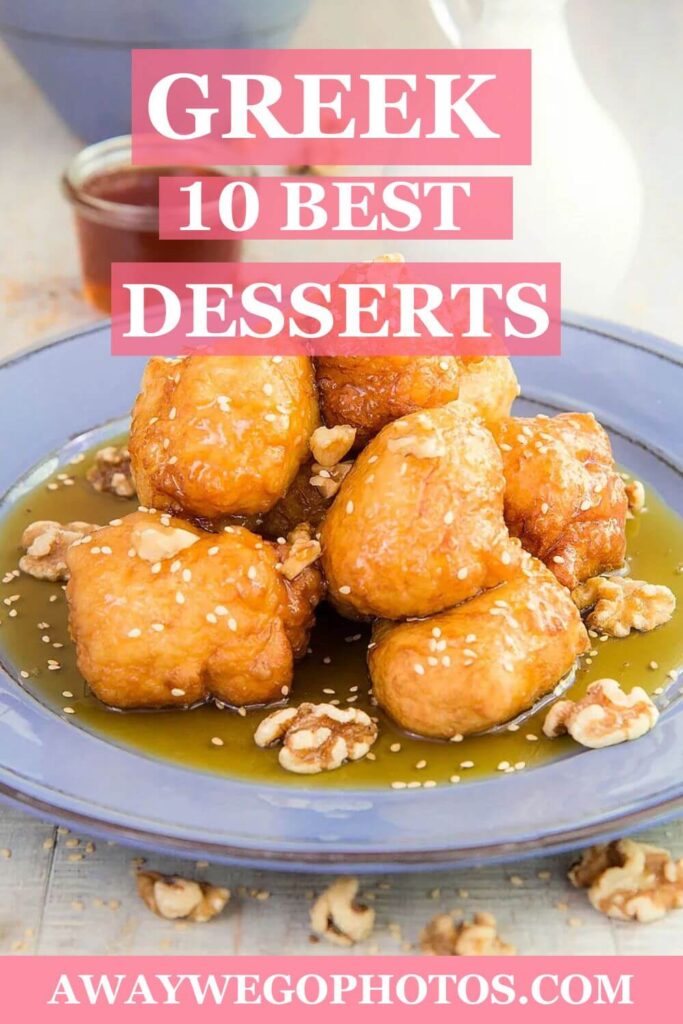Indulging in Greek desserts is like embarking on a journey through centuries of culinary heritage, where each sweet treat tells a story of tradition, culture, and a passion for flavor. From the iconic layers of baklava to the delicate sweetness of loukoumades, Greek desserts captivate the senses with their rich textures and tantalizing aromas. Rooted deeply in the Mediterranean’s bounty, these desserts often feature ingredients like honey, nuts, filo pastry, and aromatic spices, reflecting Greece’s history of trade and influences from neighboring regions.
Whether enjoyed as a celebratory delight during festivals or as a comforting treat shared among loved ones, Greek desserts offer a taste of the country’s warmth and hospitality. With recipes passed down through generations and each bite evoking memories of sun-drenched landscapes and bustling markets, exploring Greek desserts is not just a culinary experience but a cultural immersion into the heart of Greece’s sweet traditions
Ready to try Greek Desserts!
Baklava

Baklava, a beloved Greek dessert, seduces the palate with layers of delicate phyllo pastry embracing a rich filling of chopped nuts, typically walnuts or pistachios. Each golden slice is a symphony of textures, sweetened with syrup or honey and infused with the warm embrace of cinnamon, an irresistible delight.
5 Key Facts
- Origin: Baklava traces its roots to the Ottoman Empire, with its exact origins believed to be in the imperial kitchens of Topkapı Palace in Istanbul. However, it has become an integral part of Greek cuisine, particularly in regions influenced by Ottoman rule.
- Ingredients: Traditional baklava comprises layers of thin phyllo pastry, butter, and a filling of chopped nuts, often walnuts or pistachios. The pastry is generously soaked in syrup or honey, flavored with spices like cinnamon or cloves.
- Variations: While the basic recipe remains consistent, variations of baklava can be found across Mediterranean and Middle Eastern cuisines. Some versions feature different types of nuts, while others incorporate additional ingredients like rosewater or orange blossom water.
- Symbolism: Baklava holds cultural significance, often served during celebrations, festivals, and special occasions such as weddings and religious holidays. Its intricate layers symbolize prosperity, happiness, and good fortune in many cultures.
- Global Popularity: Baklava has gained widespread popularity worldwide, admired for its delicate layers, rich flavors, and irresistible sweetness. It has become a staple dessert in Greek restaurants and is cherished by food enthusiasts of various backgrounds for its unique taste and cultural significance.
Recipes to try
Loukoumades

Loukoumades are irresistible Greek doughnuts, golden and crispy on the outside, fluffy and airy on the inside. Deep-fried to perfection, they’re drizzled with honey syrup and sprinkled with cinnamon, creating a harmonious blend of sweetness and spice. These delectable treats embody the essence of Greek comfort food and culinary indulgence.
5 Key Facts
- Ancient Origins: Loukoumades have a history dating back to ancient Greece, where they were offered as a tribute to the gods during religious festivals.
- Deep-Fried Delicacy: Made from a simple batter of flour, yeast, and water, loukoumades are deep-fried until golden brown, resulting in a crispy exterior and a light, airy interior.
- Honeyed Indulgence: After frying, loukoumades are generously drizzled with honey syrup, which seeps into the doughnut’s crevices, infusing them with sweetness and moisture.
- Cultural Significance: Loukoumades are often enjoyed during celebrations, weddings, and religious holidays in Greece, symbolizing joy, abundance, and hospitality.
- Global Popularity: These delectable treats have gained popularity worldwide, with variations found in many cultures under different names, such as “lokma” in Turkey and “lukumades” in Cyprus. They are cherished for their simplicity, versatility, and irresistible taste.
Recipes to try
Galaktoboureko
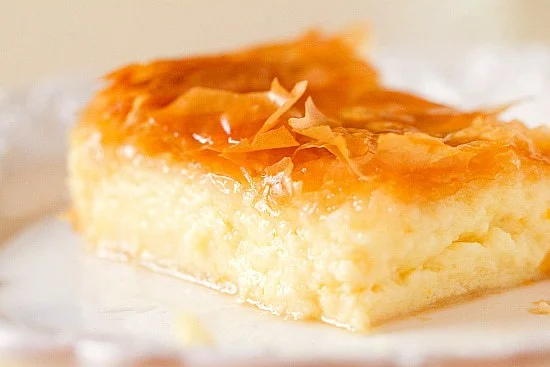
Indulging in Greek desserts is like embarking on a journey through centuries of culinary heritage, where each sweet treat tells a story of tradition, culture, and a passion for flavor. From the iconic layers of baklava to the delicate sweetness of loukoumades, Greek desserts captivate the senses with their rich textures and tantalizing aromas. Rooted deeply in the Mediterranean’s bounty, these desserts often feature ingredients like honey, nuts, filo pastry, and aromatic spices, reflecting Greece’s history of trade and influences from neighboring regions.
5 Key Facts
- Custard Delight: Galaktoboureko is a traditional Greek dessert featuring a custard filling made from semolina, milk, eggs, sugar, and flavored with lemon zest and vanilla.
- Layered Pastry: The custard filling is enclosed within layers of buttered phyllo pastry, creating a contrast between the crispy exterior and creamy interior.
- Bathed in Syrup: Once baked to golden perfection, galaktoboureko is generously bathed in a sweet syrup made from sugar, water, and lemon juice, infusing it with sweetness and moisture.
- Historical Roots: This dessert has ancient origins, with variations found in Byzantine and Ottoman cuisine, reflecting the cultural influences in Greece over the centuries.
- Celebratory Treat: Galaktoboureko is often served during festive occasions such as weddings, Easter, and other religious holidays, symbolizing abundance, prosperity, and joy in Greek culture.
Recipes to try
Kataifi
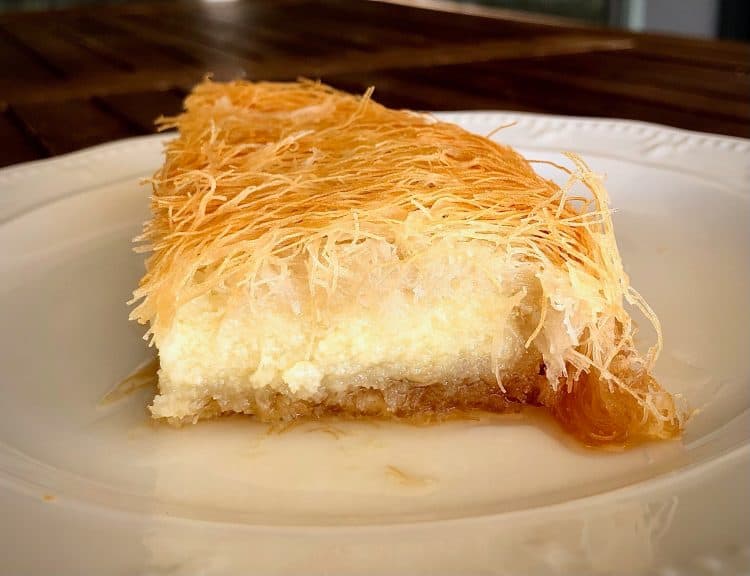
Kataifi, is a feast for the senses. Made from shredded phyllo dough, it envelops a luscious filling of chopped nuts, usually walnuts or almonds, and aromatic spices. Once baked to golden perfection, it’s drenched in a sweet syrup, creating a divine confection that delights with every bite.
5 Key Facts
- Shredded Phyllo Dough: Kataifi is a Greek pastry made from shredded phyllo dough, which gives it a unique texture compared to other desserts like baklava.
- Nut Filling: The shredded phyllo dough is typically wrapped around a filling of chopped nuts, commonly walnuts or almonds, mixed with sugar and spices.
- Sweet Syrup: After baking, kataifi is soaked in a sweet syrup, usually flavored with lemon or orange zest, which adds moisture and sweetness to the dessert.
- Versatile Treat: Kataifi can be shaped into various forms, such as rolls, nests, or pies, offering versatility in presentation and serving options.
- Cultural Significance: Kataifi is often enjoyed during special occasions and celebrations in Greek culture, such as weddings, holidays, and family gatherings, symbolizing sweetness and joyous moments shared with loved ones.
Recipes to try
Kourabiedes

Kourabiedes, traditional Greek butter cookies, are a divine indulgence. Made with a delicate blend of butter, almonds, and powdered sugar, they melt in the mouth, releasing a heavenly aroma of almond and vanilla. These crumbly delights, often enjoyed during festive occasions, embody the essence of Greek hospitality and tradition.
5 Key Facts
- Buttery Goodness: Kourabiedes are Greek butter cookies renowned for their rich, buttery flavor and crumbly texture, often enhanced with a hint of almond or vanilla.
- Powdered Sugar Coating: After baking, kourabiedes are generously coated with powdered sugar, creating a sweet and delicate outer layer.
- Almond Infusion: These cookies often contain finely chopped almonds, adding a delightful nutty crunch to each bite.
- Festive Treat: Kourabiedes are commonly enjoyed during festive occasions such as weddings, Christmas, and Easter in Greece, symbolizing sweetness and joy.
- Cultural Tradition: With recipes passed down through generations, kourabiedes hold a special place in Greek culinary heritage, embodying the warmth and hospitality of Greek culture.
Recipes to try
Melomakarona
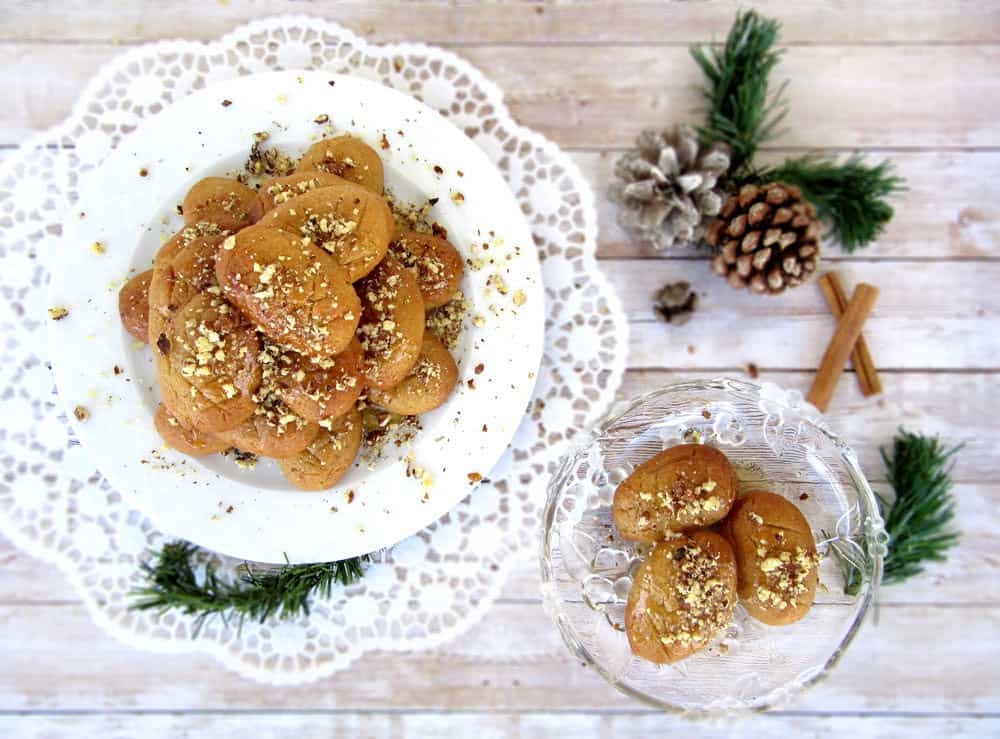
Melomakarona, beloved Greek Christmas cookies, are a symphony of flavors and textures. Made with a blend of olive oil, orange juice, and spices, they boast a moist and tender crumb. After baking, they’re soaked in honey syrup and sprinkled with chopped nuts, offering a delightful taste of festive indulgence.
5 Key Facts
- Christmas Tradition: Melomakarona are traditional Greek Christmas cookies enjoyed during the festive season, often made in households across Greece to celebrate the holiday.
- Ingredients: These cookies are made with a combination of olive oil, flour, sugar, orange juice, and spices such as cinnamon and cloves, giving them a unique flavor profile.
- Texture: Melomakarona have a moist and tender texture, thanks to the use of olive oil and orange juice in the dough, creating a delightful contrast with the crunchy exterior.
- Honey Syrup: After baking, melomakarona are soaked in a sweet honey syrup infused with spices like cinnamon and cloves, which adds moisture and sweetness to the cookies.
- Topped with Nuts: To finish, melomakarona are often sprinkled with chopped nuts, such as walnuts or almonds, adding a crunchy texture and nutty flavor to these festive treats.
Recipes to try
Pasteli
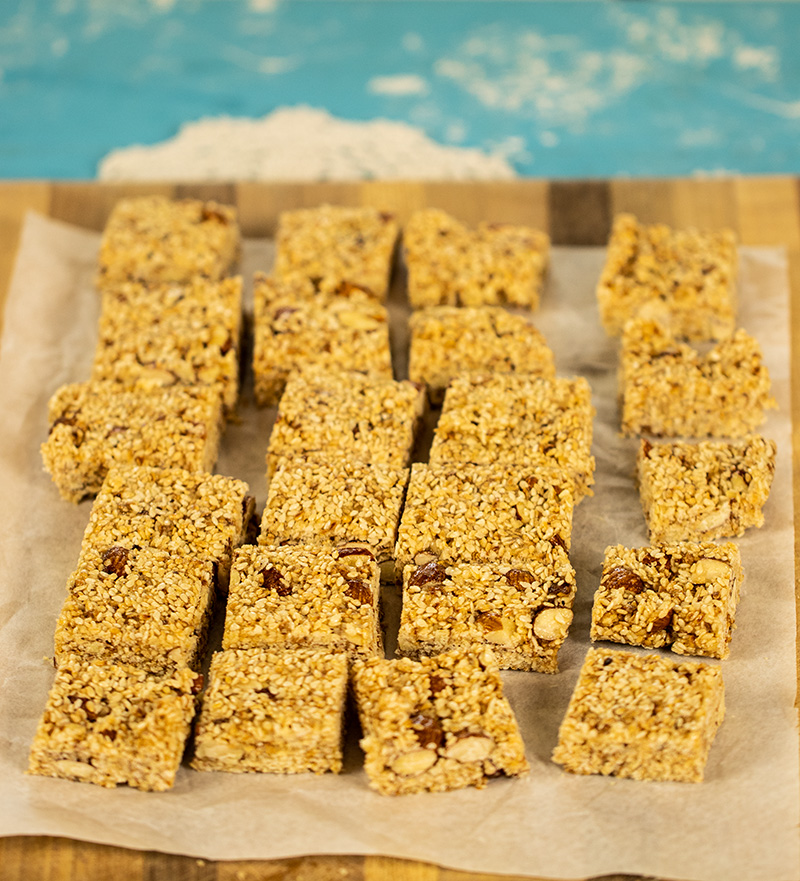
Pasteli, a traditional Greek treat, is a simple yet delightful confection. Made from just two ingredients—sesame seeds and honey—it boasts a satisfying crunch and a natural sweetness. Often shaped into bars or bites, pasteli offers a wholesome and flavorful snack that celebrates the purity of its ingredients.
5 Key Facts
- Ancient Origins: Pasteli has ancient roots, dating back to ancient Greece, where it was considered a staple food for athletes due to its energy-boosting properties.
- Minimal Ingredients: This Greek treat is made with just two simple ingredients: sesame seeds and honey, making it a nutritious and wholesome snack.
- Nutritional Value: Sesame seeds are rich in nutrients like calcium, iron, and healthy fats, while honey provides natural sweetness and energy, making pasteli a nutritious and energizing snack.
- Handmade Tradition: Pasteli is traditionally handmade, with sesame seeds mixed into warm honey, then shaped into bars or bites and left to cool and set before serving.
- Cultural Significance: Pasteli holds cultural significance in Greece, often enjoyed as a sweet treat during festivals, celebrations, and religious holidays, symbolizing hospitality, tradition, and the bounty of the land.
Recipes to try
Revani

Revani, a classic Greek dessert, is a delight for the senses. Made from semolina flour, this moist cake is soaked in a lemon-scented syrup, infusing it with citrusy sweetness. With a delicate crumb and a hint of almond flavor, revani offers a comforting and satisfying indulgence.
5 Key Facts
- Semolina Cake: Revani is a traditional Greek cake made primarily from semolina flour, giving it a unique texture compared to other cakes.
- Moist and Tender: The semolina in revani helps create a moist and tender crumb, providing a delightful eating experience.
- Lemon-Scented Syrup: After baking, revani is soaked in a sweet syrup flavored with lemon zest and juice, adding moisture and a refreshing citrusy aroma.
- Almond Flavor: Revani often includes almond flour or almond extract in the batter, giving it a subtle nutty flavor that complements the citrusy sweetness of the syrup.
- Celebratory Dessert: Revani is commonly served during special occasions such as weddings, birthdays, and religious holidays in Greece, symbolizing joy, prosperity, and the sweetness of life.
Recipes to try
Rizogalo
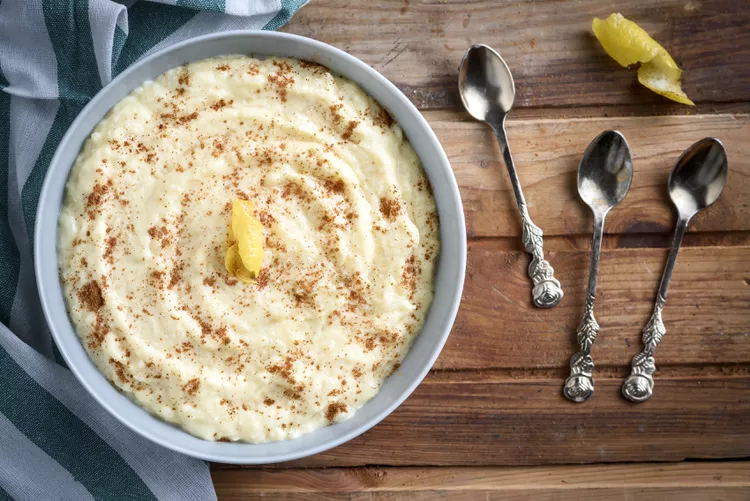
Rizogalo, a comforting Greek rice pudding, is a timeless favorite. Made with creamy Arborio rice simmered in milk, it’s sweetened with sugar and flavored with aromatic hints of vanilla and cinnamon. Served warm or chilled, rizogalo offers a taste of nostalgia and culinary comfort in every spoonful.
5 Key Facts
- Rice Pudding: Rizogalo is a traditional Greek rice pudding, known for its creamy texture and comforting flavor.
- Arborio Rice: It is typically made using Arborio rice, which has a high starch content, contributing to the pudding’s creamy consistency.
- Milk-Based: Rizogalo is cooked by simmering rice in milk, gradually thickening as it absorbs the liquid.
- Sweetened with Sugar: Sugar is added to sweeten the pudding, while aromatic ingredients like vanilla and cinnamon provide additional flavor.
- Versatile Serving: Rizogalo can be enjoyed warm or chilled, making it suitable for various occasions and preferences, whether as a comforting dessert or a refreshing treat.
Recipes to try
Loukoumades

Loukoumades, a beloved Greek dessert, are bite-sized balls of dough, deep-fried to golden perfection. Crispy on the outside and fluffy on the inside, they’re drenched in sweet honey syrup and sprinkled with cinnamon or crushed nuts. These indulgent treats are a heavenly delight, cherished for their irresistible sweetness and addictive texture.
5 Key Facts
- Deep-Fried Dough: Loukoumades are Greek doughnuts made from a simple batter of flour, yeast, water, and sometimes milk, creating a light and airy texture.
- Honey Syrup: After frying, loukoumades are generously drizzled with honey syrup, infused with flavors like cinnamon or citrus zest, adding sweetness and aroma.
- Ancient Origins: This dessert dates back to ancient Greece, where it was served during festivals and celebrations as a symbol of abundance and joy.
- Variations: While traditionally round, loukoumades can also be shaped into different forms like small balls or elongated shapes, offering versatility in presentation.
- Popular Treat: Loukoumades are enjoyed throughout Greece and beyond, often sold at festivals, markets, and street food stalls, offering a delightful indulgence loved by people of all ages.
Recipes to try
Like this Post? Save it on Pinterest!
